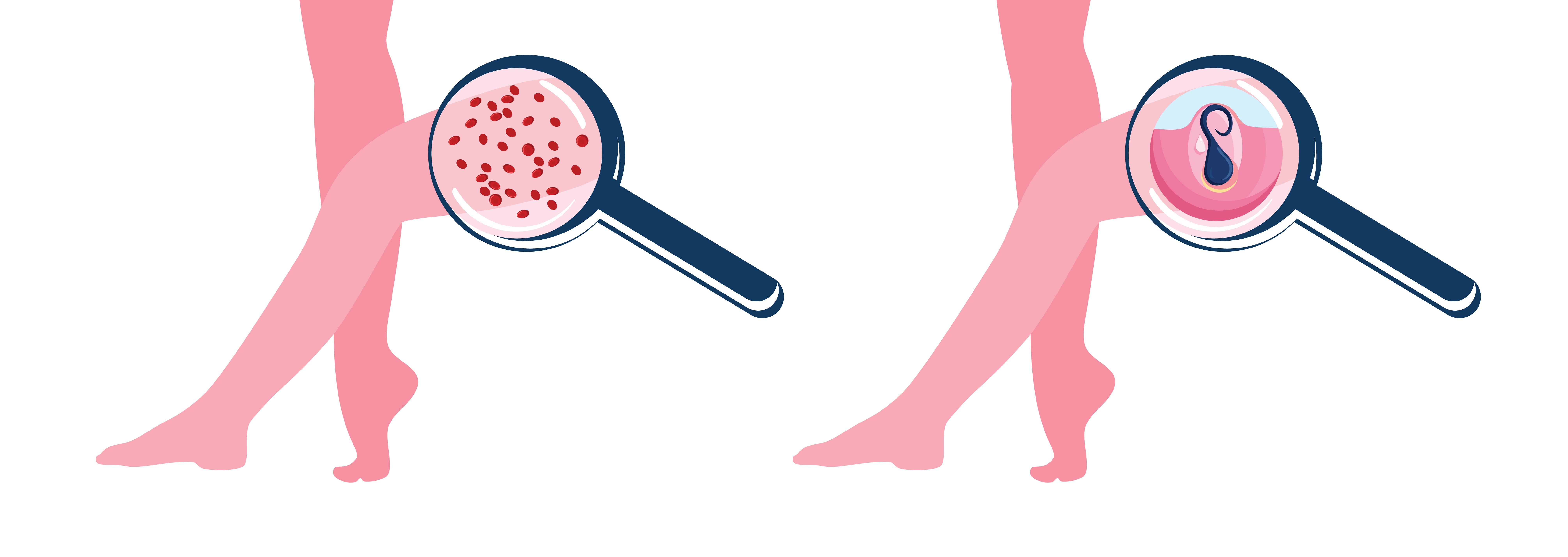Ever notice that your legs are developing teeny tiny black dots that kind of resemble the seeds or skin of a strawberry? These dark spots are hair follicles or enlarged pores. They could come from a variety of issues, including bacteria, dead skin and oil.
It’s especially common after shaving. When you have a clogged pore or a follicle that’s exposed after shaving, air reached the internal oils. This creates an oxidizing effect and turns it dark.
Causes of Strawberry Legs
If you’re asking yourself: why do I have strawberry legs? The causes of strawberry legs vary – although shaving is a common reason, different conditions can cause this unique effect.
Clogged pores
Like the rest of our skin, our legs contain thousands of pores. These clogged pores, otherwise known as comedones, can get clogged with dead skin, debris and bacteria. When the oil inside the clogged pores is exposed to air, it oxidizes, turning black.

Shaving
This commonly happens if you’re using a dull or old razor that needs to be replaced. It can also happen if you don’t use soap or shaving cream. Both of these things can lead to razor burn, which is a direct cause of strawberry legs. Ingrown hair can also cause this look, and is common if you have thicker body hair. For other people, the skin surrounding the follicle darkens in response to the irritation it experiences from shaving.

Folliculitis
Sometimes, our hair follicles can get infected or inflamed. Folliculitis can occur from waxing, shaving or any other method of hair removal that leaves the hair follicle open and at a higher chance of exposure. It can also happen if you’re been exposed to a fungus, yeast, or bacteria.
Folliculitis is a common result of using a hot tub without properly regulated pH or chemicals. This inflammation disorder usually starts as tiny red bumps or blisters, later resulting in scabs that can take a while to heal. It can also cause a darkened skin appearance, especially if it’s related to ingrown hairs struggling to break through.

Keratosis Pilaris
A common yet benign condition, Kerastosis pilaris most often shows up on the skin of your upper arms and thighs. They’re tiny bumps that can resemble goosebumps, pimples, or “chicken skin” and are hard to the touch. This is caused by the build-up of keratin and dead skin cells.

Dry skin
Severely dehydrated skin can cause or worsen strawberry legs and other conditions like Keratosis pilaris that resemble it. Excessive dryness can cause the skin to be more easily irritated during shaving, making you more susceptible to razor burn, strawberry legs and folliculitis.

What are the symptoms of strawberry legs?
- Pitted/dotted appearance on leg skin
- Darkened open pores on legs
- Black or brown dots showing up after shaving

How are strawberry legs treated?
Luckily, you can easily treat your strawberry legs at home. You can both prevent and treat strawberry legs by:
- Using a moisturizing shave lotion or cream
- Shaving slowly and properly
- Switching to an epilator, a hand-held electrical hair remover that removes hair from the root.
- Exfoliating regularly can remove dead skin cells and ingrown hairs
- Using an over-the-counter product with glycolic acid/salicylic acid

Professional treatments
There are also clinical treatments like electrolysis and laser therapy. Laser therapy can be used for long-term hair removal with multiple treatments that are targeted, whereas electrolysis consists of using low electricity levels to pinpoint the hair follicles with problems.
Doctors may also prescribe therapies for the infected follicle in the form of oral antibiotics, antibiotic creams, or gels. If your issue is fungus or yeast, you may be prescribed anti-fungal topical or oral treatments.

The bottom line
All in all, strawberry legs can be managed quite easily, especially if you employ prevention tactics and home remedies. But the solution may not be as simple for those with thicker body hair, hair follicle issues or darker skin, and professional treatment may be the way to go.
Although epilators aren’t as comfortable or painless as we’d like, they’re one of the best preventative measures, as is applying shaving cream before your skin touches the razor.
Also, try to choose a razor that has blade flexibility or a pivoting head. This will allow it to contour to your curves better. You can also exfoliate or dry brush one or two days before shaving to draw out impurities.
Ultimately, although this skin issue can be annoying, it’s not the end of the world and there are plenty of measures you can take to deal with it proactively.
